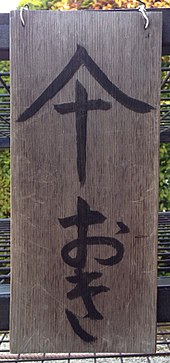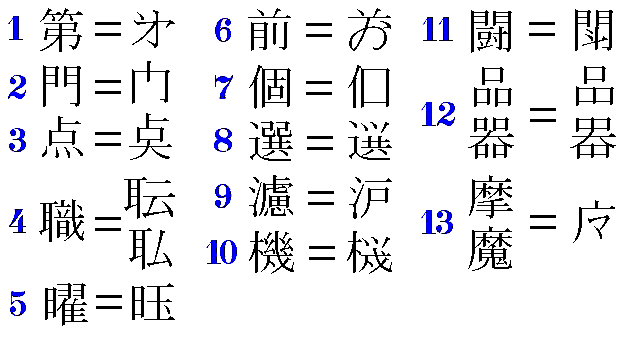Ryakuji


 |
| Japanese writing |
|---|
| Components |
| Uses |
| Romanization |
In Japanese language, Ryakuji (Japanese: 略字 "abbreviated characters", or 筆写略字 hissha ryakuji, meaning "handwritten abbreviated characters") are colloquial simplifications of kanji.
Status[]
Ryakuji are not covered in the Kanji Kentei, nor are they officially recognized (most ryakuji are not present in Unicode). However, some abbreviated forms of hyōgaiji (表外字, characters not included in the tōyō or jōyō kanji lists) included in the JIS standards which conform to the shinjitai simplifications are included in Level pre-1 and above of the Kanji Kentei (e.g., 餠→餅, 摑→掴), as well as some other allowances for alternate ways of writing radicals and alternate forms. Some ryakuji were adopted as shinjitai.
Some simplifications are commonly used as special Japanese typographic symbols. These include:
- 々, the kanji iteration mark, from 仝, a variant of 同;
- 〻, the vertical form, from 二;
- the hiragana and katakana iteration marks, ゝ and ヽ, generic strokes;
- 〆, shime, simplification of 占 (as 占め しめ shime) as cursive form of top component ト, used for various kanji read as しめ shime, primarily 締め, also 閉め, 絞め, 搾め, and original 占め;
- ヶ, small ke, simplification of 箇 (also used for 個), though with other uses.
Of these, only 〆 for 締 and ヶ for 箇 are generally recognized as being simplifications of kanji characters.
Replacements of complex characters by simpler standard characters (whether related or not) is instead a different phenomenon, kakikae. For example, in writing 年齢43歳 as 年令43才 (nenrei 43 sai "age 43 years"), 齢 is replaced by the component 令 and 歳 is replaced by 才, in both cases with the same pronunciation but different meanings. The replacement of 齢 by 令 is a graphic simplification (keeping the phonic), while 歳 and 才 are graphically unrelated, but in both cases this is simply considered a replacement character, not a simplified form. Other examples include simplifying 醤油 shōyu (soy sauce) to 正油.
Compare this to simplified Chinese.
Use[]
Ryakuji are primarily used in individual memos, notes and other such forms of handwriting. Their use has declined in recent years, possibly due to the emergence of computer technology and advanced input methods that allow equally fast input of both simple and complex characters. Despite this, the ryakuji for 門 (mon, kado; gate) and for characters using the radical 門 are still widely used in handwriting.[1]
Abbreviations for multiple-character words or phrases[]
In all cases discussed in the other sections of this article, individual characters are simplified, but separate characters are not merged. There are rare cases of single-character abbreviations for multiple-character words or phrases, such as 圕 for 圖書館, 図書館 toshokan, "library", but this is very unusual; see polysyllabic Chinese characters for this phenomenon in Chinese, where it is more common.
Examples[]

Notes[]
Of these, several are commonly seen in signs: 2門 12品 12器 are very commonly seen, particularly simplifying 間 in store signs, while 1第 and 5曜 are also relatively common, as is
